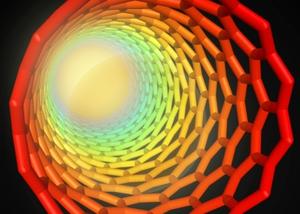WaterThermopower waves advance a new energy future
Thermopower waves in thermoelectric materials can convert heat from solid fuels into electrical energy, in research that advances the vision of “smartdust” and other truly autonomous micro and nanomachines; “smartdust” systems are micro-electromechanical systems that are networked wirelessly for sensing and receiving data, for example testing pH of soil in large agricultural fields or quality of water reserves

Illustration of heated carbon nanotube // Source: mit.edu
Researchers at the Royal Melbourne Institute of Technology (RMIT) have explored how thermopower waves in thermoelectric materials can convert heat from solid fuels into electrical energy, in research that advances the vision of “smartdust” and other truly autonomous micro and nanomachines
Study supervisor, Associate Professor Kourosh Kalantar-zadeh, said thermopower waves could be used as micro-power sources for a broad range of miniaturized applications.
“Tiny electronic devices powered by thermopower waves could apply large energies to targeted cancer cells inside the human body, enabling an exceptional level of precision in cancer treatment,” he said.
“They could help realize concepts like ‘smartdust’ — micro-electromechanical systems that are networked wirelessly for sensing and receiving data, for example testing pH of soil in large agricultural fields or quality of water reserves.”
Lead author Sumeet Walia, a doctoral researcher in the Microplatforms Research Group at RMIT, said the size of power sources had not kept pace with the ever-reducing size of electronics. “The development of miniaturized energy sources is a key challenge to overcome in order to build the next generation of electronic devices,” Walia said.
“We focus on thermopower waves — which generate intense waves of electrical current by sweeping electrical carriers from one end of materials to another — because of their potential for creating small scale power sources that can release energy at very high rates.
“Our work demonstrates a new class of micro-power sources and shows it is possible to obtain alternating output signals with opposite polarities, which is crucial for developing alternating signal sources. This is an important milestone towards making efficient thermopower wave systems for future industrial applications.”
Walia co-authored the study with researchers from the CSIRO and University of New South Wales, under the supervision of Associate Professor Kalantar-zadeh.
— Read more in Sumeet Walia et al., “Sb2Te3 and Bi2Te3 based thermopower wave sources,” Energy & Environmental Science (26 July 2011) (DOI: 10.1039/C1EE01370J)
